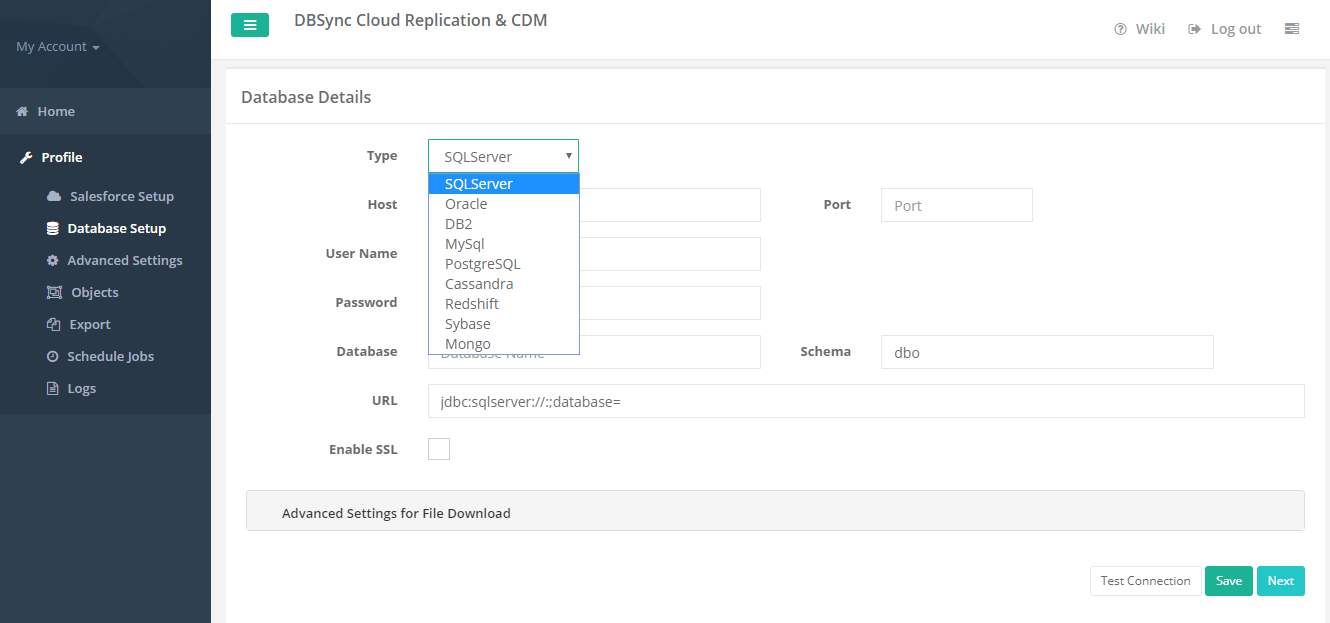2022
Page History
...
- Once, you have logged in then click to "main menu" in the right hand top corner on the home page of DBSync replication portal.
- Next, enter the required proxy credentials in different text boxes like proxy host, port, username and password under the global settings section.
- Click on save changes Click on save changes button to save a global settings details.
...
- Click to "add profile" in the right hand-corner of the profiles section of DBSync replication portal.
- Select, the required source name application from the drop down menu under the product header.
- Next, enter the name of the profile like "testprofile" under the name section.
- Click Click on save changes button to create a new replication profile.
Figure:2
...
- Click to "Salesforce and Microsoft CRM" setup tab on the left hand corner in the profiles section of DBSync replication portal.
- Don't change the "environment and soap end details", all these details are pre-filled.
- Next, enter the "username" and "password" credential for Salesforce and Microsoft CRM.
Figure:3 - "OR", "Other option for Salesforce" Click on connect to Salesforce (OAUTH) to enter Salesforce login credentials like "Usernameusername" and "Passwordpassword" to connect the Salesforce Applicationsalesforce application.
Figure:4 - Click on Test Connectiontest connection button to validate your Source Application source application login details.
Figure:5 - Click on Savesave button to save your Source Apps source apps login details.
Figure:6 - Once completed, click on Next button on next button to proceed to Database Setup database setup tab.
Configure database setup details
...
Follow these steps to configure your database credentials with different databases like MySQLMySql, SQL Server, Oracle, DB2DB, PostgreSQL, Cassandra, RedShift, Sybase and MongoDB.
- Click to "database" setup tab on the left hand corner in the profiles section of DBSync replication portal.
- Select, the required "type namename" from the the drop down menu options like "MySql, SQL Server, Oracle, DB2DB, PostgreSQL, Cassandra, RedshiftRedShift, Sybase and MongoDB" under the "database setup" section.
Figure:7
(Note: The database URL can also be entered manually if you know your database Connection string.) - To start with database credentials user has to entered all the configuration details like host, port, username, password, database name and schema.
- To start with database credentials user has to entered all the configuration details like host, port, username, password, database name and schema.
- Once, all the details enter by the user then URL details will get autofilled.
- Click on test Connection button to validate your source application login details.
- Click on save button to save your source apps login details.
- Once completed, click on next next button to proceed to advanced advanced settings tab to write to get the email Id to get the notificationsnotifications.
Note:
- While replicating with Cassandra, please refer the following wiki link for specific details on Replication with Cassandra.
http://help.mydbsync.com/docs/display/CloudReplication/3+-+Big+Data+Support
While replicating with Amazon Redshift database, please refer the following wiki link for specific details on Replication with Amazon Redshift. http://help.mydbsync.com/docs/display/CloudReplication/Amazon+Redshift
Advanced settings tab details
Start with Advanced Settings advanced settings tab, to fill all the necessary details and follow the same procedure for testing and validating Advanced settings credentials.
Follow these steps to configure your Advanced settings credentials.
- Click to "Advancedadvanced" Settingssettings tab on the left hand corner in the Profiles section of DBSync Replication Portal.
- Mark the checkbox to "Enable Database enable database logging" to create auto created table in the database.
- Next, Mark the checkbox of checkbox of "Email email only on Errorerror" to get an email message when error will occur.
- Enter an email for "Email Recipientemail recipient" to to get the notification when any run command is executed.
- Click on Save button to save your Advanced settings details.
- Once the process is completed then click on Save & Next buttons to proceed further.
...
Follow these steps to synced all objects for source application like Salesforce and Microsoft CRM.
- Click to "Objectsobjects" tab on the left hand corner in the Profiles section of DBSync Replication Portal.
- Once, user has connected to source applications like Salesforce and Microsoft CRM then objects will get synced and it will show on the Objects tab.
- Select any Source Apps objects you "source apps objects" you want to sync into Database from the left Objects section as shown below.
Figure:9 - Select the object fields you want to sync into Database database from the "Available available Fields" section and use "Exclude Fieldsexclude fields" section to filter out fields you don't want to sync into Databasedatabase.
Figure:10 - Once completed, click on the "Runrun button" to to Run the configuration for the Source Apps source apps object.
Figure:11 - Run menu to select the required commands like Update Database Schema, Source Apps to Database update database schema, source apps to database (Clean Copy), Source Apps source apps to Database database (Incremental) to to execute.
As per the above commands here user has to to select the Clean copy and Source to Database command to replicate all the sync objects to their Databasedatabase. - Once user has selected and "Run" the Command, then it will redirect to user on the Log Screen Tab to see the status of command is completed or not.
Below section explains the steps involved in Source Apps to Database Replication.
Run Process | Actions Performed |
Update Database Schema | Creates Source Apps schema into Database for the selected Source Apps objects. |
Source Apps to Database (Clean Copy) | Inserts a clean copy of selected Source Apps object records into respective Database Tables & Columns. |
Source Apps to Database (Incremental) | Performs an incremental syncfrom Source Apps to Database based on the changes / edits made in Source. |
Configure
...
schedule jobs tab
Start with Scheduler Jobs tab, here users can schedule the sync using Scheduler Tab.
...


